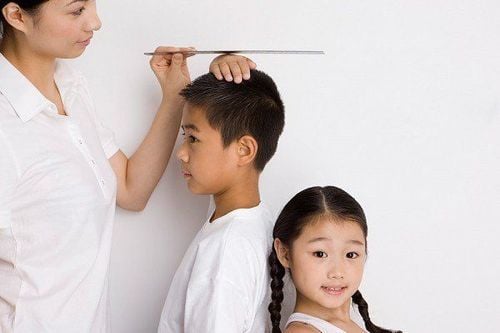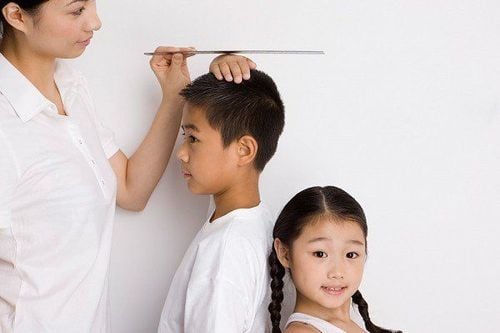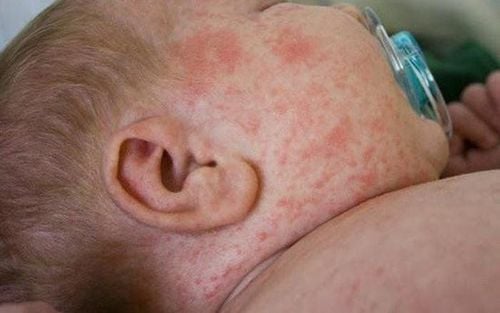Girls tend to mature faster than boys, and the age at which a girl stops growing in height depends on the age at which she has her first menstrual period. However, the physical condition of each girl is different, so some children may experience early or late puberty. This can significantly affect their growth.
1. When do girls stop growing in height?
The timing of puberty plays a key role in determining when a girl will stop growing in height. The age at which a girl reaches her adult height depends on when she starts menstruating.
Some of the first signs of puberty in girls often include breast development, pubic or underarm hair growth, and discharge. These are all signs that girls may start growing taller sooner than before. According to the American Academy of Pediatrics, girls in puberty will experience a growth spurt after their breasts begin to develop or 2-3 years after their first menstrual period.
Girls will stop growing in height and reach their final adult height just 2-2.5 years after their first menstrual period. Most girls will grow at a rapid rate throughout childhood. When girls reach puberty, their height growth rate increases dramatically. In general, girls usually stop growing in height at the age of 14 or 15.

2. How does puberty affect girls' height?
Most girls will have a growth spurt in height in the 1-2 years before they start menstruating. Puberty in girls usually occurs between the ages of 8 and 13, and girls' height growth usually occurs between the ages of 10 and 14. Girls only increase their height by 1-2 inches in the year or two after their first period. This is when they reach their adult height.
Most girls will reach their adult height by the age of 14 or 15. However, this age can be younger depending on when the girl first starts menstruating. If a girl is 15 but has not started menstruating, parents should take her to see a pediatrician for specific advice about delayed puberty.
3. Does the rate of height growth in girls differ from that of boys?
Typically, puberty comes a little later in boys than in girls. Generally, boys will start puberty between the ages of 10 and 13 and go through a growth spurt between the ages of 12 and 15. This means that the peak height growth in boys occurs about 2 years later than in girls.
Moreover , most boys will stop growing in height by the age of 16, but their muscles may continue to develop.

4. What is the average height of a baby girl?
According to the Centers for Disease Control and Prevention (CDC), the average adjusted height for adult women aged 20 and older is 63.7 inches, which is just under 5 feet 4 inches.
According to research, about half of the girls in the U.S. will be shorter than 50.2 inches (127.5 cm) at the age of 8. This demonstrates that a lot of growth happens over a short period of time.
Below is a table of average height by age for females, measured in inches and centimeters.
| Age | Average height (inch and cm) |
| 8 | 50,2 inch (127,5 cm) |
| 9 | 52,4 inch (133 cm) |
| 10 | 54,3 inch (138 cm) |
| 11 | 56,7 inch (144 cm) |
| 12 | 59,4 inch (151 cm) |
| 13 | 61,8 inch (157 cm) |
| 14 | 63,2 inch (160,5 cm) |
| 15 | 63,8 inch (162 cm) |
| 16 | 64 inch (162,5 cm) |
| 17 | 64 inch (163 cm) |
| 18 | 64 inch (163 cm) |
5. What is the role of genetics in height development in girls?
A person's height is significantly influenced by the height of their parents. Therefore, height growth patterns often tend to be inherited within families. When assessing a child's growth, pediatricians usually ask parents to provide basic information about their own height, the family's height history, and any patterns of height development.
Additionally, other methods can be applied to predict a girl's height. One of the most common methods is predicting a child’s height based on the heights of the father and mother. For this calculation, you add the heights of both parents (in inches), then divide by two. After that, subtract 2.5 inches for a girl. For a boy, you would add 2.5 inches instead, to get the predicted final height.
For example, if a girl’s father is 72 inches tall and her mother is 66 inches tall, the predicted height for the girl would be calculated as follows:
- step 1: 72 + 66 = 138
- step 2: 138/2 = 69
- step 3: 69 – 2.5 = 66.5
Therefore, the predicted height of the girl is 66.5 inches, which is equivalent to 5 feet 6.5 inches. However, this number is only a rough estimate, and the margin of error can be up to 4 inches. In general, the taller the parents, the taller the children are likely to be, and vice versa.
6. What causes delayed development in girls?
In fact, many important factors significantly affect a person’s growth, ranging from malnutrition to the use of medications.
Some girls may experience delayed height growth due to certain health conditions, such as severe arthritis, growth hormone issues, or cancer. Additionally, some genetic conditions are closely related to growth delays in girls. For example, girls with Noonan syndrome, Down syndrome, or Turner syndrome may be shorter than other family members. However, girls with Marfan syndrome may be taller than others in their family.
If you're concerned about your child’s growth, you should consult a pediatrician for thorough advice. When a girl reaches puberty, growth will stop a few years after her first menstrual period. Generally, if a child experiences delayed growth during puberty, they will have less time to grow before the rapid growth phase ends.

7. When should you take a child to see a doctor?
If a girl's physical development seems to be significantly ahead of or behind her peers, parents should take her to see a pediatrician as soon as possible. For girls who show no signs of breast development by age 13 or have not had their first menstrual period by ages 15 or 16, this is considered delayed puberty. On the other hand, if a girl shows signs of puberty at age 6 or 7, this would be considered early puberty.
Healthcare experts recommend that if a girl has either of these conditions, it is best to see a pediatrician to check for medical or hormonal problems that are causing early or late puberty. Additionally, the doctor may perform a bone age X-ray to determine whether the child is on track to reach average adult height.

8. How to optimize height growth for girls?
Girls can grow in height from childhood until puberty. In general, to achieve optimal and healthy height, girls should establish good habits from an early age, including getting enough sleep, eating nutritious foods, and exercising daily.
Additionally, if there are any abnormalities in a child’s height growth, it is best for parents to consult a pediatrician as soon as possible to help the child grow optimally.
With many years of experience in diagnosing and treating pediatric conditions, the Pediatrics Department at Vinmec International General Hospital has become one of the leading healthcare centers capable of examining, screening, and treating many specialized medical conditions. Therefore, if a child shows signs of early puberty or slow height growth, parents can bring the child to Vinmec International General Hospital for an examination, early puberty screening, and to receive support and advice from doctors and nutrition experts to help the child develop comprehensively and healthily.
To arrange an appointment, please call HOTLINE or make your reservation directly HERE. You may also download the MyVinmec app to schedule appointments faster and manage your reservations more conveniently.
References: healthline.com, .parents.com













